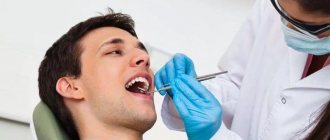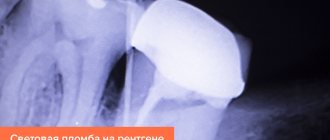When visiting public and private dental clinics, most people pay attention to the doors of the offices, where signs are posted with various names of doctors’ specialties, including “dentist” and “dentist”. Without knowing the features of these two professions, you might think that these specialists have identical job responsibilities, but this is completely wrong!
Delving a little deeper into history, you can find the answer to what is the difference between a dentist and a dentist, because the profession appeared in the Russian Empire long before today - in 1710, when sick teeth began not only to be pulled out, but to be treated.
According to the decree of Peter I, the first dental school in the empire was created, its task was to train specialists with highly specialized medical practice. Also, to stimulate the development of professional dentistry, a decree was issued according to which dental procedures could only be performed by certified specialists - this provoked a rapid growth in the number of dental faculties at universities, and also gave impetus to the development of dentistry as a science with a number of positive changes, first of all , improving the quality of treatment for problems in the oral cavity.
Who is a dentist?
Before dealing with narrow specializations, let’s consider who a dentist is in general. This is a doctor who has a higher education and has the right to carry out all types of dental treatment from therapeutic to prosthetics.
There are also dentists. Despite the fact that people call all dentists this way, in fact they are specialists with secondary specialized education. Their field of activity is dental treatment, but they do not have the right to undergo surgery.
In addition to dentists who work directly with patients, there is a dental technician. This specialist is engaged in the manufacture of prosthetics.
Categories of dentists
Dentists are required to confirm their qualifications every 5 years
Each dentist has a certain qualification category, which is an indicator of the level of his theoretical knowledge and practical skills.
The procedure for assigning a qualification category is determined by order of the Ministry of Health of the Russian Federation.
Dentists are required to confirm their qualifications every 5 years.
Those who wish to improve their qualifications themselves must wait 3 years from the date of the last certification.
Regulatory documents provide for three types of categories in ascending order:
- second (is basic);
- first;
- highest.
Requirements for various categories:
| Category | Requirements |
| Second | Work experience in the specialty for at least 3 years. Successful completion of certification. |
| First | Work experience in the specialty for at least 7 years. For a specialist with secondary education – at least 5 years. Successful completion of certification. |
| Higher | Work experience in the specialty for at least 10 years. For a specialist with secondary education – at least 7 years. Successful completion of certification. |
Dentist-therapist
The second name of this specialist is odontologist. The main function of this doctor is to treat caries and its complications. The first thing you meet with a dental therapist is when you come to the dental clinic. He makes an initial examination and decides on treatment methods. His qualifications are sufficient to install fillings in carious cavities. During the filling process, the doctor examines each tooth individually in order not only to cure caries, but also to recognize other defects. He also treats gums and other inflammatory processes in the oral cavity. A dental therapist can diagnose the disease and select individual treatment or refer you to another specialist.
Diagnostics
On average, a diagnosis by an orthodontist takes 30 to 40 minutes, but can take several days. It all depends on the patient’s desire to take certain photographs. Standard procedures included in the diagnostic list:
- visual inspection;
- a panoramic photograph that allows you to see the full view of the jaws, including the roots of the teeth, wisdom teeth, and tooth buds;
- teleroentgenogram (TRG). It allows you to determine the cause of the anomaly, see the relationship of the jaws, and draw a conclusion about what treatment methods will be required;
- 3D scanning or taking impressions of the jaws, with the help of which the exact dimensions of the jaw are determined;
- photographing. It allows you to assess changes in the patient’s appearance and the dynamics of treatment;
- 3D analysis or computed tomography (CT). Required if the doctor suspects a non-standard tooth tilt or other complex problems;
- video recording that allows you to record functional disorders in movement.
Dentist-orthodontist
If you have problems with your bite or your teeth have grown unevenly, then you can contact an orthodontist for this problem. This doctor specializes in correcting malocclusions and straightening teeth. According to scientific research, an incorrect bite can not only spoil your appearance, but also create problems with the digestive system and cause diseases of the jaw bones.
The orthodontist takes an impression of the jaw and then uses it to make braces or aligners that will help straighten the teeth. Then the entire structure is installed, and the doctor tells you how to care for it. The entire treatment period is monitored by the orthodontist until the desired result is achieved. Treatment can last from several months to several years. Before contacting an orthodontist, it is necessary to check the health of your teeth and, if necessary, undergo treatment from a dental therapist, and possibly from a surgeon.
Basic methods of orthodontic treatment
Without knowing what exactly the patient came with, it is impossible to say what the orthodontist will do , because the methods of influence primarily depend on the problem and defects in the dentition. Sometimes you can get by with minimal interventions, in other cases you need to involve a dental surgeon.
The most popular methods of dental orthodontism are myotherapy or myogymnastics, hardware treatment and surgical intervention. It is rare that these methods are used in their “pure” form; usually the doctor combines them, forming the course of treatment necessary for a particular patient.
Myotherapy
Myotherapy is one of the ways to strengthen the muscles of the maxillofacial area, thanks to which the formation of anomalies in childhood can be avoided. Based on theoretical calculations about orthodontic treatment, we can conclude that this is the safest and least effective method. Therefore, myogymnastics is almost never prescribed separately.
During classes, the child needs to perform two types of exercises:
- dynamic, when the muscles of the face and jaw sometimes tense and then relax;
- static, forcing the organs to be in tension all the time.
Considering that the exercises must be systematic, classes require adult supervision. Also, it is the parent or teacher who checks that the tasks are completed correctly, because the child may forget or not understand the doctor. The specialist selects tasks, then teaches the adult the exercises, then the adult checks the child.
Myogymnastics class in a children's group: warm-up
Hardware method
The frequency of use of the method clearly shows: an orthodontist is a doctor who treats with fixed and removable hardware systems. The most famous of them are braces, mouth guards and trainers, and plates. When installed, they act on individual teeth, causing them to slowly but surely move in the desired direction. As a result, all elements of the oral cavity occupy their intended position.
Treatment with devices has certain limitations. So, corrections are possible if:
- sufficient force is applied to the tooth, i.e. the equipment is assembled correctly and installed correctly;
- the device has a reliable support and is well fixed;
- there is a place in the dentition into which a stray element can fit;
- there are no obstacles in the path of the tooth being moved.
If these rules are not followed, the dental orthodontist corrects this , and then installs braces, plates or other devices. Sometimes it takes a lot of time to prepare, because it is necessary to remove excess teeth and wait for the restoration of the oral cavity.
Surgical method
If the diagnosis shows that the deformation of the development of the dental arches, jaws or malocclusion is too pronounced, it is necessary to resort to surgical methods. The most popular types of surgical intervention:
- exposure of the crown of an impacted tooth (i.e., removal of the upper gum tissue above a tooth that has not erupted correctly);
- rotation of the tooth around its axis, as a result of which the element falls into place in the dentition correctly;
- removal of individual teeth of irregular shape, extra teeth, as well as those that cannot be “fitted” into the jaw for some reason, etc.
In some situations, surgical intervention falls under the purview of what an orthodontist does . If the specialist cannot correct the situation on his own, he gives the person a referral to a dental surgeon.
Dentist-periodontist
This doctor specializes in treating the soft tissues of the mouth. If your gums are bleeding or inflamed, there are problems with the mucous membrane or something similar, the periodontist will select a treatment and relieve you of these problems.
During the treatment process, it is mandatory to sanitize the oral cavity, remove tartar, and replace crowns if they begin to rub. As a rule, drug treatment is selected that relieves inflammation. However, in some advanced cases, the help of a surgeon or orthopedist is required.
Table: how to figure out who to contact
| What's troubling? | Which dentist should I contact? |
| Bleeding gums/Teeth sensitivity | Hygienist or periodontist |
| Missing teeth | Orthopedist |
| Have crooked teeth/bad bite | Orthodontist |
| Tooth hurts / The wall has broken off / There is caries | Therapist |
| The wisdom tooth is painfully erupting / Swelling has appeared on the side of the cheek | Surgeon |
All dentists conduct an examination, consultation, draw up a treatment plan and perform a thorough diagnosis of the entire oral cavity. In modern dentistry, an integrated approach to each clinical situation is valued, taking into account all the individual characteristics of the patient’s body.
Dental hygienist
This doctor's specialty is not treatment, but prevention of oral diseases. Dental hygienists provide consultations to help their patients prevent tooth decay and other diseases, since most of them occur due to improper care. The hygienist will tell you and show you how to brush your teeth correctly and help you choose the right dental care products. His qualifications also include removing plaque and tartar, which often cause gum disease.
Pros and cons of the profession
Like any other occupation, this profession has its pros and cons. Its advantages include:
- consistently high demand in the labor market,
- high level of payment,
- good career prospects, especially in science,
- opportunity to open your own business.
However, it also has its drawbacks. This is a great responsibility, and the need to work in a stressful situation, and some monotony of professional activity. Also worth mentioning is the high cost of medical education and further training.
Pediatric dentist
This doctor specializes in dental treatment for children under 17 years of age. His specialization requires him to know the specifics of the formation of the dentofacial apparatus at different age periods in order to notice the appearance of deviations in time.
Many parents refuse to treat caries on baby teeth, believing that they will soon fall out and healthy molars will grow in. However, this judgment is not entirely correct. If the decay of a baby tooth is too intense, the molar tooth that has not yet erupted may be damaged.
Also, pediatric dentists must be able to get along with kids and know their psychology in order to persuade a small patient to undergo examination and treatment. These doctors treat, fill teeth, and also apply special linings that prevent teeth from decaying ahead of time.
We have analyzed the main specializations of dentists. This profession is more multifaceted than it seems at first glance. In practice, it often happens that each specialist knows the specifics not only of his own work, but also of other doctors and can carry out a set of measures to treat the oral cavity.
Related materials:
dentist | Givenchy | SEPHORA COLLECTION | Dior | Givenchy | Sephora | Dior | teeth | white teeth | smile | beautiful smile | prosthesis | surgery
Articles
- In the know: fall makeup trends August 29, 2015, 00:00
- Virtual Stylist: The Most Stylish Apps December 17, 2021, 00:00
- Pastel makeup: making accents January 25, 2021, 00:00
Video
- New birth of four-color shadows from Givenchy September 15, 2010, 00:00
- Little tricks for a dazzling smile from Givenchy October 20, 2010, 00:00
- Beauty in Korean October 24, 2021, 12:00
Principles of remuneration in public and private clinics
The difference between private and public dentistry in remuneration can be quite significant. For example, in the capital, a dental therapist in a public clinic receives 50-60 thousand rubles , but in a private clinic, all other things being equal, he will receive 80-120 thousand rubles. In public medical institutions, a dentist’s salary consists of the official salary and various allowances. Among other things, such specialists receive additional payments for qualification categories, for a scientific degree (if any), etc.
In private clinics, salaries are calculated differently. At the same time, such institutions often compete with each other for good specialists, so everyone pays high salaries, and additionally attracts staff with good working conditions - a social package, modern equipment and optics, the presence of assistants, etc.
As a rule, if a dentist does not open his own office, but goes to work as an employee, then a plan for services is set for him, or more precisely, for their total amount. Depending on this, he receives the initially established percentage. At the same time, good clinics set a very realistic plan, taking into account the experience of previous months, and it is not difficult to implement it.
Salary for percentage
Pricing is usually determined by the clinic’s management. But in general, the price of relatively simple manipulations is determined by the cost of the materials used, to which a certain markup is added. However, in some areas of dentistry, the so-called technical cost of work is used - this is, for example, relevant for crowns and veneers, which are made not by the dentist himself, but by a dental technician. In this case, the percentage for calculating the salary of the dentist-therapist will be calculated a little differently. The markup itself can be almost any amount. In private clinics, it includes both payment of taxes and salaries of all staff, so it can be 200% or more.
Gray additional methods earnings
It also happens, of course, that not very conscientious doctors impose additional services where they could have done without it (mostly this concerns some aesthetic problems or professional oral hygiene services, but in general in reputable clinics this rarely happens).
Bonuses and awards
Most private clinics do not offer additional bonuses or bonuses. But some institutions practice training employees in courses and seminars at their own expense, and there are also those that include meals for employees in their benefits package.
Penalties
But there is a system of fines. Basically, they fine small sums for various violations of labor discipline - for example, for being late or for untimely filling out medical documentation. If the doctor makes any mistakes in treatment, then more stringent measures can be taken.
When working in a private clinic, you need to keep in mind that although the registration will be official everywhere, the management still wants to save on taxes. Therefore, many register as part-time doctors in order to minimize their contributions to the tax and pension fund.
Other professions: Average salary of a welder in the Russian Federation and the World?
Reviews
- No. 1. Becoming a dentist requires a certain amount of persistence and determination. It took me a total of about 8 years to study, and I didn’t even count how many times I attended various seminars and conferences after receiving my diploma (well, there were already courses twice). I didn’t immediately understand what direction I wanted to work in, and only after the internship I came to the conclusion that I would be a pediatric dentist. Working with such patients is not easy, but there are more positive emotions. After the appointment, I always give my patients some kind of souvenir - soap bubbles or balls with the symbols of our clinic, and on my own behalf - certificates for bravery, I simply print them out on a printer. I work in a private clinic, the salary is 80-90 thousand rubles per month. Our team is good, overall I’m happy with everything.
- No. 2. I myself work as a dental surgeon, and my wife is a dental therapist. When we had the opportunity, we opened our own office. It wasn’t easy, and it wasn’t even a matter of finding clients; we literally lured many away when we left our previous place of work. It’s just that organizing an office is an expensive pleasure, considering all the standards. We try not to raise the markup too much in order to retain customers - the competition is still quite strong, and we set aside part of the money for upgrading equipment, so my monthly salary is 77-80 thousand rubles, my wife gets about the same (75 on average ).
Resume sample
To find a job faster, you need a resume that can be sent to several companies at once. You need to know how to compose it correctly.
The resume must include:
- Full Name;
- Date of Birth;
- contact details: phone, email;
- citizenship;
- experience;
- basic and additional education;
- professional skills;
- knowledge of languages;
- personal qualities.
The resume should be simple and understandable; there is no need to write or invent a lot, because then in practice all the qualities and abilities of the specialist will be assessed.
Principles of training
If you decide to become a dentist, then you need to understand that this profession is very responsible. Therefore, it is necessary to obtain a medical education.
Those who are interested in dentistry are wondering: how long to study to become a dentist and what is needed for this. To enter a university, you must:
- complete 11 grades in a secondary school;
- pass the appropriate exams in biology, chemistry and Russian.
It is necessary to understand whether a person is ready for this profession. To obtain a specialty in this field, you need good study and a specific goal, as well as the ability to find an approach to even the most picky and harmful patients.










